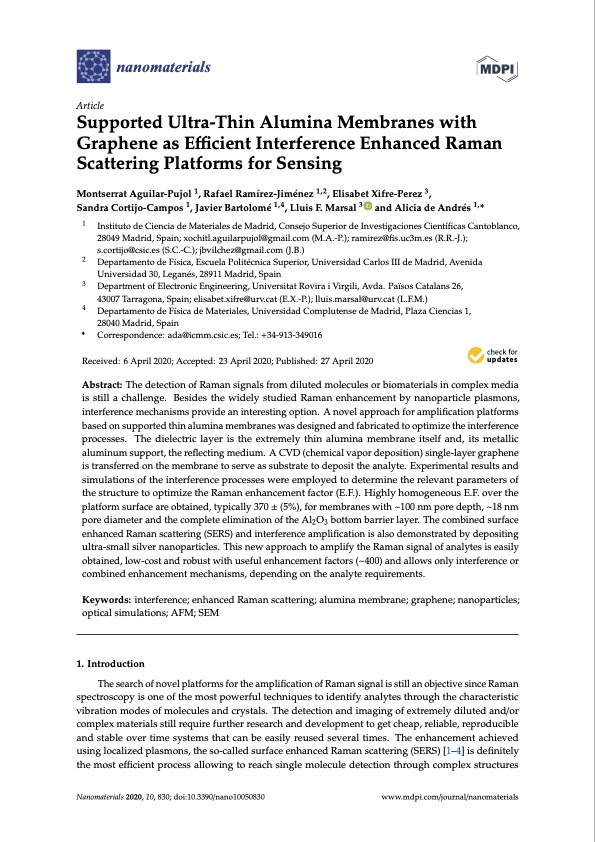
PDF Publication Title:
Text from PDF Page: 001
nanomaterials Article Supported Ultra-Thin Alumina Membranes with Graphene as Efficient Interference Enhanced Raman Scattering Platforms for Sensing Montserrat Aguilar-Pujol 1, Rafael Ramírez-Jiménez 1,2, Elisabet Xifre-Perez 3, Sandra Cortijo-Campos 1, Javier Bartolomé 1,4, Lluis F. Marsal 3 and Alicia de Andrés 1,* 1 2 3 Instituto de Ciencia de Materiales de Madrid, Consejo Superior de Investigaciones Científicas Cantoblanco, 28049 Madrid, Spain; xochitl.aguilarpujol@gmail.com (M.A.-P.); ramirez@fis.uc3m.es (R.R.-J.); s.cortijo@csic.es (S.C.-C.); jbvilchez@gmail.com (J.B.) Departamento de Física, Escuela Politécnica Superior, Universidad Carlos III de Madrid, Avenida Universidad 30, Leganés, 28911 Madrid, Spain Department of Electronic Engineering, Universitat Rovira i Virgili, Avda. Països Catalans 26, 43007 Tarragona, Spain; elisabet.xifre@urv.cat (E.X.-P.); lluis.marsal@urv.cat (L.F.M.) Departamento de Física de Materiales, Universidad Complutense de Madrid, Plaza Ciencias 1, 28040 Madrid, Spain 4 * Correspondence: ada@icmm.csic.es; Tel.: +34-913-349016 Received: 6 April 2020; Accepted: 23 April 2020; Published: 27 April 2020 Abstract: The detection of Raman signals from diluted molecules or biomaterials in complex media is still a challenge. Besides the widely studied Raman enhancement by nanoparticle plasmons, interference mechanisms provide an interesting option. A novel approach for amplification platforms based on supported thin alumina membranes was designed and fabricated to optimize the interference processes. The dielectric layer is the extremely thin alumina membrane itself and, its metallic aluminum support, the reflecting medium. A CVD (chemical vapor deposition) single-layer graphene is transferred on the membrane to serve as substrate to deposit the analyte. Experimental results and simulations of the interference processes were employed to determine the relevant parameters of the structure to optimize the Raman enhancement factor (E.F.). Highly homogeneous E.F. over the platform surface are obtained, typically 370 ± (5%), for membranes with ~100 nm pore depth, ~18 nm pore diameter and the complete elimination of the Al2O3 bottom barrier layer. The combined surface enhanced Raman scattering (SERS) and interference amplification is also demonstrated by depositing ultra-small silver nanoparticles. This new approach to amplify the Raman signal of analytes is easily obtained, low-cost and robust with useful enhancement factors (~400) and allows only interference or combined enhancement mechanisms, depending on the analyte requirements. Keywords: interference; enhanced Raman scattering; alumina membrane; graphene; nanoparticles; optical simulations; AFM; SEM 1. Introduction The search of novel platforms for the amplification of Raman signal is still an objective since Raman spectroscopy is one of the most powerful techniques to identify analytes through the characteristic vibration modes of molecules and crystals. The detection and imaging of extremely diluted and/or complex materials still require further research and development to get cheap, reliable, reproducible and stable over time systems that can be easily reused several times. The enhancement achieved using localized plasmons, the so-called surface enhanced Raman scattering (SERS) [1–4] is definitely the most efficient process allowing to reach single molecule detection through complex structures Nanomaterials 2020, 10, 830; doi:10.3390/nano10050830 www.mdpi.com/journal/nanomaterialsPDF Image | Supported Ultra-Thin Alumina Membranes with Graphene

PDF Search Title:
Supported Ultra-Thin Alumina Membranes with GrapheneOriginal File Name Searched:
nanomaterials-10-00830-v2.pdfDIY PDF Search: Google It | Yahoo | Bing
Turbine and System Plans CAD CAM: Special for this month, any plans are $10,000 for complete Cad/Cam blueprints. License is for one build. Try before you buy a production license. More Info
Waste Heat Power Technology: Organic Rankine Cycle uses waste heat to make electricity, shaft horsepower and cooling. More Info
All Turbine and System Products: Infinity Turbine ORD systems, turbine generator sets, build plans and more to use your waste heat from 30C to 100C. More Info
CO2 Phase Change Demonstrator: CO2 goes supercritical at 30 C. This is a experimental platform which you can use to demonstrate phase change with low heat. Includes integration area for small CO2 turbine, static generator, and more. This can also be used for a GTL Gas to Liquids experimental platform. More Info
Introducing the Infinity Turbine Products Infinity Turbine develops and builds systems for making power from waste heat. It also is working on innovative strategies for storing, making, and deploying energy. More Info
Need Strategy? Use our Consulting and analyst services Infinity Turbine LLC is pleased to announce its consulting and analyst services. We have worked in the renewable energy industry as a researcher, developing sales and markets, along with may inventions and innovations. More Info
Made in USA with Global Energy Millennial Web Engine These pages were made with the Global Energy Web PDF Engine using Filemaker (Claris) software.
Infinity Turbine Developing Spinning Disc Reactor SDR or Spinning Disc Reactors reduce processing time for liquid production of Silver Nanoparticles.
| CONTACT TEL: 608-238-6001 Email: greg@infinityturbine.com | RSS | AMP |